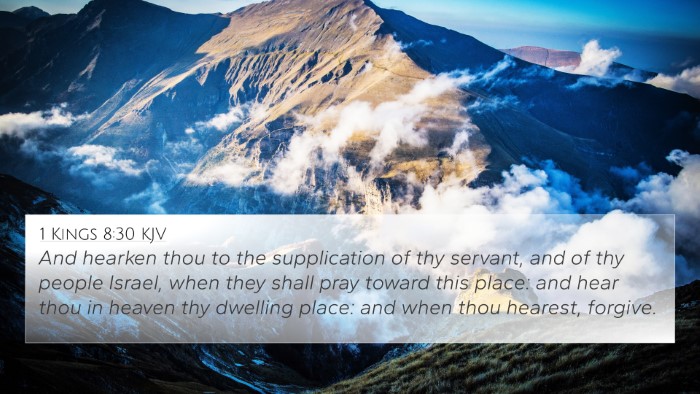Understanding Isaiah 38:2
Isaiah 38:2 says, "Then Hezekiah turned his face toward the wall and prayed to the LORD." This verse depicts a moment of fervent prayer from King Hezekiah when he faced a grave illness and received a dire prophecy from the prophet Isaiah concerning his impending death.
Context and Background
This prayerful act occurs when Hezekiah is confronted with the reality of his mortality. It is essential to examine the thematic and textual connections throughout the Bible to fully appreciate the gravity of this moment.
Commentary Insights
- Matthew Henry's Commentary: Henry emphasizes the earnestness of Hezekiah’s prayer. Turning his face to the wall signifies an intimate, personal connection with God, prioritizing heartfelt communication over public display. Henry suggests that this action reflects humility and a focused spirit in times of crisis.
- Albert Barnes' Notes: Barnes highlights the aspect of desperation in Hezekiah's prayer. He notes that the king, recognizing his utter reliance on God, sought divine intervention. This illustrates the importance of seeking God in times of personal trial and being sincere in prayer.
- Adam Clarke's Commentary: Clarke discusses the significance of Hezekiah's prayerful posture. He notes that the “wall” may represent the barriers or obstacles that Hezekiah felt, but also reflects a turning away from worldly distractions to focus solely on God. Clarke also underscores the concept that prayer is a vital tool in accessing God’s mercy and intervention.
Key Themes and Connections
In this verse, we find various themes emerging that warrant attention:
- Trouble and Distress: Hezekiah’s situation demonstrates a common biblical theme where individuals confront overwhelming distress.
- Desperation in Prayer: The act of praying facing the wall symbolizes the depths of Hezekiah’s plea, a reflection seen in numerous other biblical instances.
- God's Response to Prayer: The immediate response from God showcases the power of sincere prayer, evoking connections to texts that portray God’s readiness to respond to believers in their need.
Related Bible Cross-References
This verse connects profoundly with several other scriptures that echo its themes and teachings:
- 2 Kings 20:2-6: This recounts the same event and God's promise of healing to Hezekiah.
- Psalms 30:2: “O Lord my God, I cried out to You, and You healed me.” This aligns with Hezekiah’s trust in God’s power to heal.
- James 5:16: This New Testament verse emphasizes the power of prayer, linking to Hezekiah’s earnest plea.
- Philippians 4:6-7: “Do not be anxious about anything, but in everything by prayer and supplication…” connects to the encouragement of prayer in distress.
- Jeremiah 29:12-13: “Then you will call upon me and come and pray to me, and I will hear you.” This speaks to God’s assurance to those who seek Him.
- Luke 18:1: “Men ought always to pray and not lose heart,” reinforcing the relentless nature of Hezekiah’s prayer.
- Matthew 7:7: “Ask, and it will be given to you…” highlights God’s promise to respond to sincere prayers.
Inter-Biblical Dialogue and Thematic Analysis
This verse serves as a key example in a broader thematic analysis of prayer and divine intervention. The connections between various scriptures allow us to see a tapestry woven through God’s encouraging messages about prayer, trust, and deliverance. Hezekiah's story parallels those of others throughout the Bible, such as Job in his suffering or David in his psalms, who turned to God with their pleas.
Conclusion
Isaiah 38:2 encapsulates the essence of faithful supplication during times of trial. By consulting various commentaries and cross-referencing, one appreciates the deep layers of meaning this verse presents.
Tools for Further Cross-Referencing
For those wishing to delve deeper into the connections between Bible verses and enhance their understanding of scriptural interactions:
- Utilize a Bible concordance to find verses related to key terms and themes.
- Consider a Bible cross-reference guide for systematic study.
- Employ cross-reference Bible study methods to explore themes comprehensively.
- Engage with Bible reference resources available for deeper theological insight.
Identification and Connection Methodologies
For those seeking to identify connections between scriptures:
- Examine thematic Bible verse connections to find scriptures that resonate on similar topics.
- Reflect on inter-Biblical dialogue which enriches understanding of scripture relationships.
- Study the comparative analysis of Pauline epistles for a focused look into the Apostle’s teachings.
- Create Bible chain references that link verses thematically or contextually.
Utilizing these tools and approaches, one can deepen their understanding and appreciation of the rich interconnections found within the scriptures.






